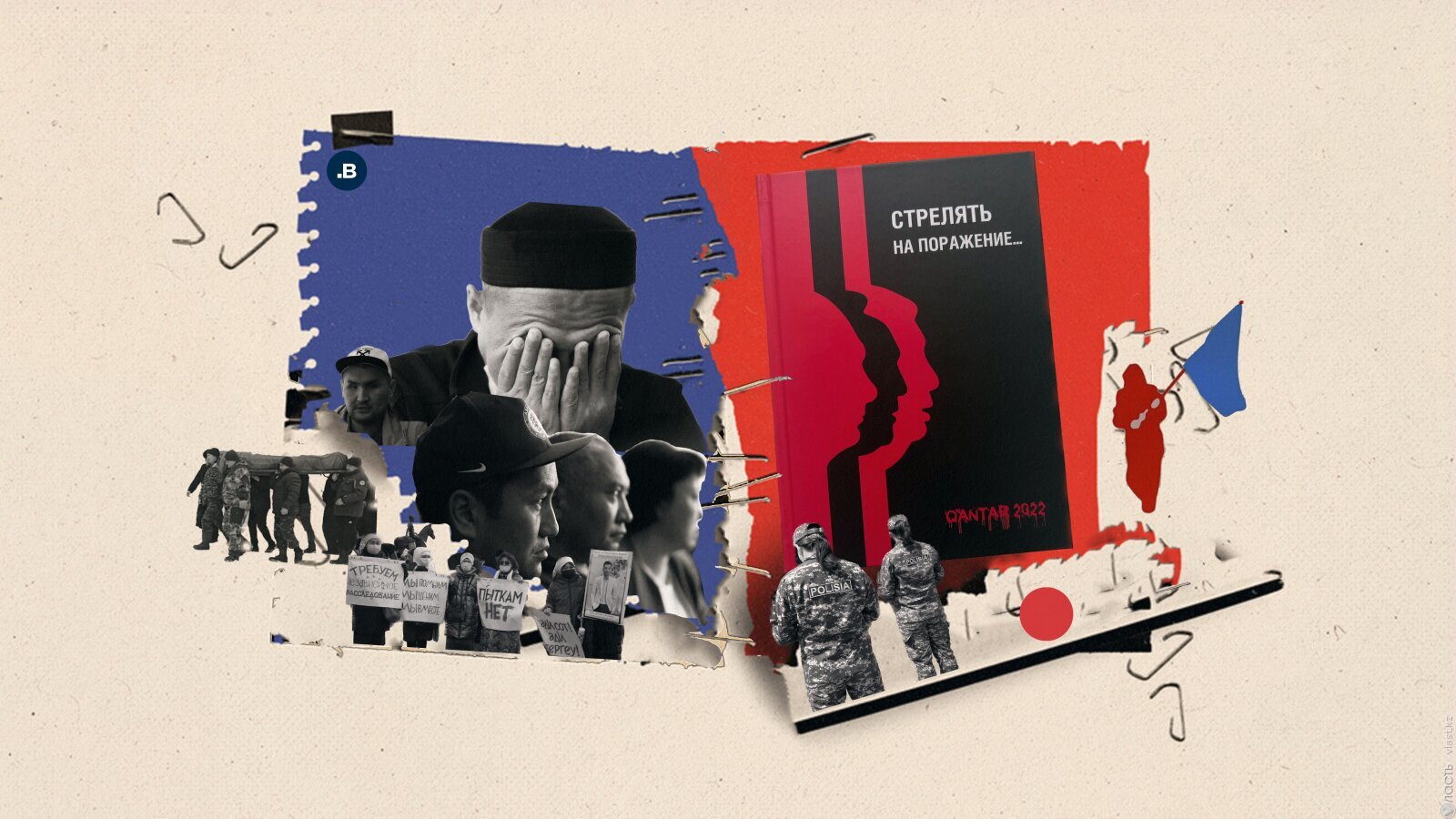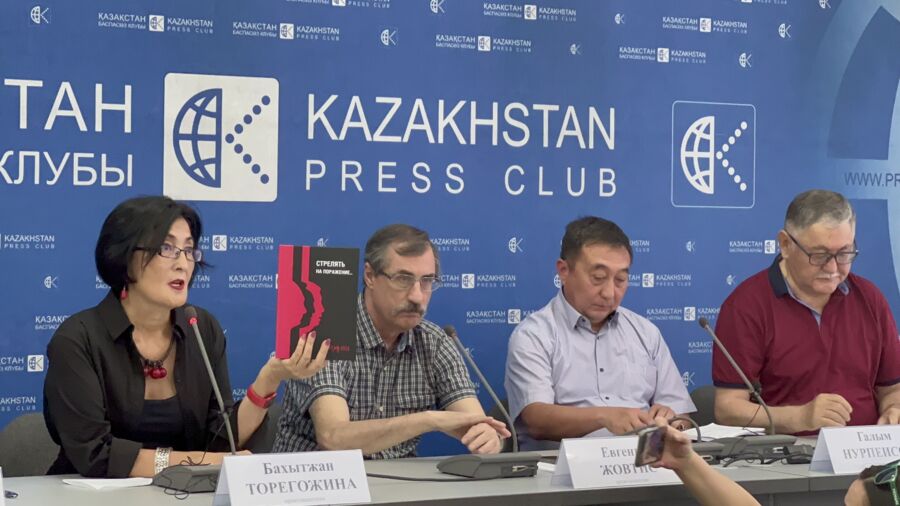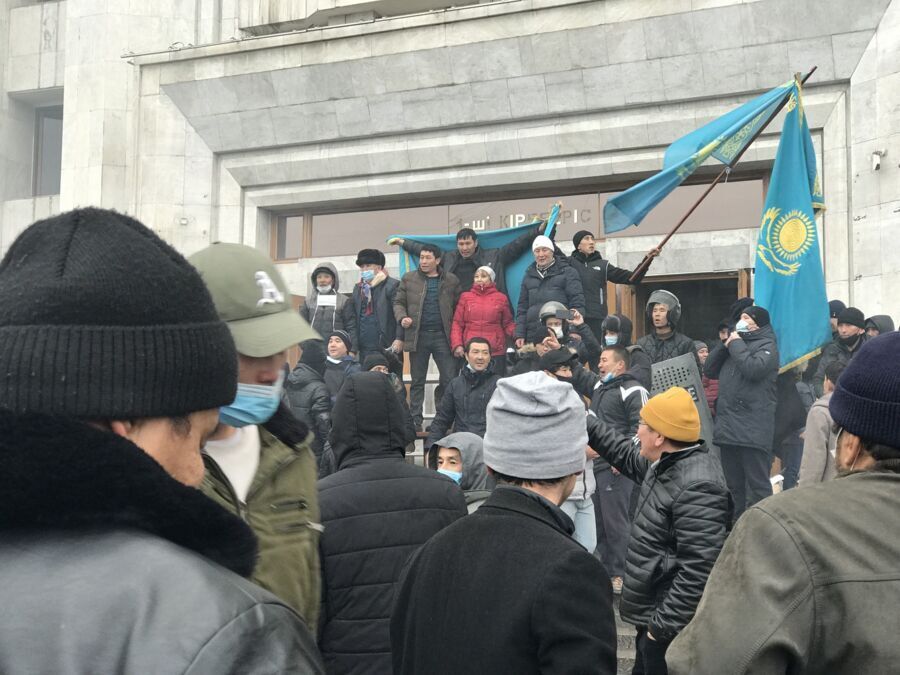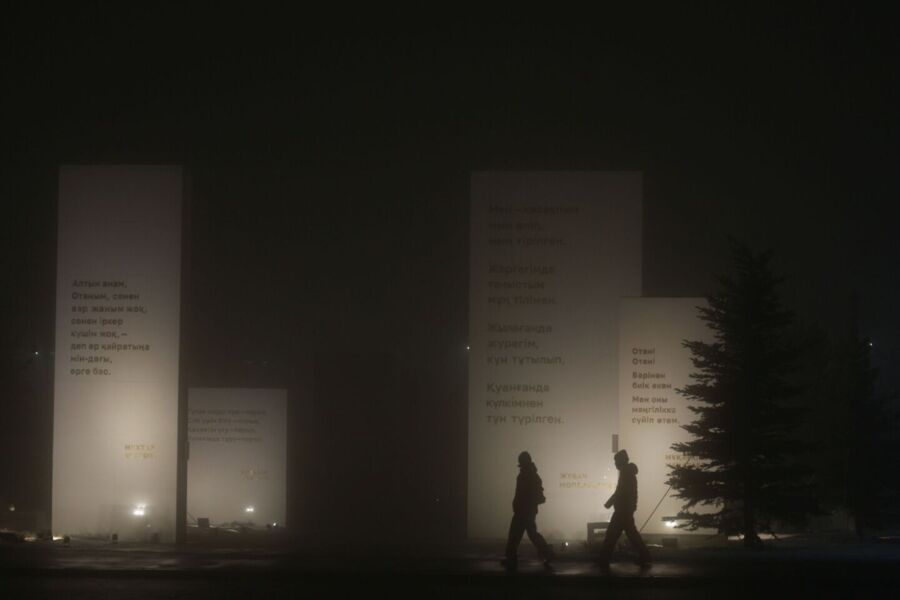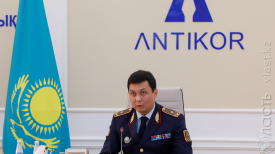On June 5, the Human Rights Alliance for Fundamental Rights released a report titled “Shoot to Kill”, focusing on the January events of 2022. The authors showed evidence of gross violations of citizens’ rights and freedoms. The report also details socio-demographic portraits of several victims.
The Human Rights Alliance in Support of Fundamental Rights is an association of Kazakhstani human rights advocates, established on 14 January 2022 at the initiative of the Kazakhstan International Bureau for Human Rights and Rule of Law. Bakytzhan Toregozhina and Yevgeny Zhovtis, leading members of the Alliance, penned the report.
What Happened and Who Is to Blame?
The report starts with a summary of how Qandy Qantar (Kazakh for “Bloody January”) turned from peaceful protests into riots across several regions. The report concludes that the protests were “quickly and deliberately coordinated” by groups with “a certain degree of organization and a command structure affiliated with the security services and the top leadership of the KNB (the National Security Committee).”
Human rights activists believe that the right to freedom of assembly was unreasonably restricted during the days of the January events, citing as an example the use of excessive force against peaceful demonstrators, as a result of which many people were injured and killed.
The authorities disseminated information about “20,000 terrorists,” which was later refuted. The government failed to provide a comprehensive picture of how the events were “organized” (despite repeating there was a single hand behind the turmoil). Prosecutor General Berik Assylov stated in parliament that the former head of the KNB, Karim Massimov, was the architect of the riots. His trial was held behind closed doors. We only know that Massimov and his deputies were sentenced to up to 18 years in prison for “high treason”, “attempting a coup" and other crimes.
“Who really organized everything and where was the unified headquarters for coordinating militant groups to create chaos and riots in more than 11 regions of the country? If such a center really existed, one could [learn] about it from the documents from the trial of Karim Massimov and his subordinates, however, [it] is labeled ‘top secret’,” the report states.
“Another extremely important point: why did the state ‘snooze’ in the presence of covert militant cells? Who are these militants? Where was the command post, and who was at the helm? Where are these militants now?,” the human rights activists ask in the report.
Other trials of senior officials, including the former minister of defense, were also held behind closed doors.
“Several criminal cases, even against ordinary employees of the national security agencies (especially in connection with the use of lethal weapons against civilians) were also classified. This makes it difficult for relatives and the victims themselves to obtain information and create an objective and complete picture of what happened,” the authors state.
Torture and Arrests
Human rights activists report that about 8,500 people were detained during Qandy Qantar. Мore than 3,000 of them were arrested for 15 days for violating the law on peaceful assemblies. The activists recorded 600 cases of detainees facing gross violations of their rights and freedoms, including torture.
The authors cite, among others, the case of trade union leaders from Mangistau, in the west of the country. On the evening of January 6, Kospan Kosshygulov, a trade union leader, went to meet his colleagues Amin Yeleusinov and Takhir Erdanov, after an assembly with the protesters in Aktau. Their car was surrounded by people who then abducted the three. They put hoods on them, took away their phones, and locked them in a container. They were kept there for about two hours. According to Kosshygulov, the people who abducted them looked like athletes and members of organized crime groups. The three were then transferred to another house, where they were kept until the evening of January 7. They were released only after the rallies in Aktau had ended.
The detentions were often carried out by law enforcement officials in plain clothes, who gave no specific reasons. People could be detained just because their contact details appeared on the address books of other detainees. Some were detained for having a video from the rallies saved to their phone's camera roll. Torture and other forms of ill-treatment “were employed everywhere, both to intimidate and to extract confessions."
For example, court documents from a case filed against 11 KNB officers, revealed that a number of illegally detained citizens were held hostage by an armed private security agency in a yellow container in the Ainabulak microdistrict in Almaty and subjected to beatings. After that, they were transferred to another container near the airport, where KNB officers and soldiers tortured them.
Human rights activists welcomed the announcement by the Prosecutor General's Office on 5 January that 329 torture cases were being investigated.
“Nevertheless, it is clear that the majority of law enforcement officials, unfortunately, were not held responsible for attacks on protesters and arbitrary detention of thousands of peaceful demonstrators and passers-by,” the report says.
"I Gave the Order…"
The Human Rights Alliance questions the legitimacy of President Kassym-Jomart Tokayev’s order to shoot to kill without warning during the January events. According to international law, they argue, a government should only decree the deadly use of force under specific circumstances.
“The level of violence in Kazakhstan did not qualify as a situation of armed conflict or in accordance with the definition of the ‘global war on terror’. The case in Kazakhstan was not an interstate armed conflict,” the authors write in the report, adding that the parties to the conflict were the top leadership of the KNB and various groups within the country.
According to the authors, the government failed to “establish a distinction between civilians and non-civilians when using weapons was not observed.”
“As a result, we consider the vast majority of killings of civilians during Qantar arbitrary and illegal,” human rights activists state, citing as an example the deaths of 12-year-old Sultan Kylychbek and 4-year-old Aikorkem Meldekhan in Almaty.
The activists also add that the security forces did not undergo proper training. Court documents confirmed that they arbitrarily fired shots at pedestrians and moving cars, “only on the basis of the presidential order to shoot to kill without warning.”
At the time of writing, they say, 95% of the cases of those who were killed had not undergone proper investigation, were suspended, or were classified. The authors suggest that the amnesty announced in October 2022 may have allowed the security forces to avoid criminal liability. Human rights activists had warned about this last year.
Trials and Sentences
As noted in the report, until 10 January 2022, it was difficult for lawyers to access their clients. Some of the lawyers were threatened by soldiers that they might be shot under the “shoot to kill” decree if they insisted on meeting with the detainees. Even later, during the pre-trial investigation phase, lawyers and relatives of the detainees complained about red tape, failure to provide information, opaque practices, and coerced confessions.
Nursultan Isayev, a resident of the northern city of Aktobe, was sentenced to 15 years for accidentally hitting two police officers while escaping in his car from urban clashes. At a press conference on June 5, activist Bakhytzhan Toregozhina compared his story to the essential impunity that the law enforcement enjoyed.
“Isayev inflicted only light bodily injury [to the two officers he hit], while soldiers were sentenced to only six years for killing civilians. Is there a discrimination here? Are regular people of a different category from the military personnel? We want the authorities to return to these cases,” Toregozhina said.
The report also focuses on non-compliance with the principle of the presumption of innocence. On 5 January 2023, Prosecutor General Assylov defined civil activist Aigerim Tleuzhanova “a member of an extremist religious organization” and “the organizer of the airport hijacking” before the court verdict. In the report, the Alliance also documents at least 400 cases of victims being forced to confess their guilt under torture.
On 5 January 2023, the Prosecutor General's Office said that 99% of the 1,221 court cases led to convictions.
Only four people were acquitted on all counts: Bakhtiyar Taishov, a resident of Almaty, Zhanmurat Ashtayev, an activist from Shymkent, and Aslanbek Omarov and Yernur Azhniyazov from Aktobe.
The report also details how two people in Kyzylorda, seven in Taraz, and six in Almaty were posthumously convicted for participating in mass riots. Other cases in Shymkent, Kyzylorda, and Taraz against deceased plaintiffs were discontinued.
So far, according to the report, the courts sentenced the perpetrators of only 12 out of 238 killings, the total death toll of the January events.
State Apologies
The Human Rights Alliance reports that the victims have filed 54 lawsuits seeking compensation for moral and material damage, as well as formal apologies. At least 50 of these lawsuits were dismissed. Only in four claims, as of today, did the court rule to pay moral damages between 2 and 4 million tenge ($4,500 - $8,900).
At the press conference, Toregozhina said that the state had officially apologized to 15 citizens and their families for unlawful prosecution or loss of life during the January events.
“We are seeking payment of moral damages and an apology. There are not very many of them, we counted about 200 people across the country, whose criminal cases have been dismissed,” said Toregozhina.
The Human Rights Alliance also said that peaceful protesters continue to face problems, such as seizure of property, freezing of bank accounts, and denial of notary services, all due to the restrictions they faced after being detained and prosecuted.
Not a single victim of the January events has been rehabilitated, the activists said, even the victims who lost their lives, including 4-year-old Aykorkem Meldekhan and 12-year-old Sultan Kylychbek. The activists say the parliament should adopt a law “On the rehabilitation of peaceful participants and victims of the January events of 2022”.
Who Were the Victims?
In “Shoot to Kill”, the Human Rights Alliance also meticulously reported statistics on the victims. Numbers showed that lives were lost in eight different regions during the January events. The most brutal massacres and violations of human rights occurred in the city of Almaty (26.4%), in the Almaty region (17.1%, mainly in Taldykorgan), and in the East Kazakhstan region (14.9%, mainly in Oskemen).
Most of the victims were men of an average age of 33. In the south of Kazakhstan, however, the age profile is lower, around 27 years. “Perhaps this is a consequence of the high population density and youth unemployment in these regions,” the authors say.
Those who were injured or lost their lives were mostly either workers (34.9% and 32%) or self-employed (29.2% and 36%). Entrepreneurs and businessmen accounted for only 6.3% of the killed.
“Unemployed residents, drivers involved in private cabs, security guards, gym instructors, flea market vendors, and repairmen were among the victims, as well as civil activists and opposition figures,” says the Human Rights Alliance in its report.
Official data established that out of the 219 civilians that lost their lives, 41 people were ex-cons, 67 were suspected of participating in mass riots, 142 violated the state of emergency or the anti-terrorist operation, 22 were killed by accident, four died while committing other crimes, six died as a result of torture.
The Alliance’s data reported 60.1% cases of illegal detention, 41.8% of beatings, 35.9% of psychological pressure, 33.9% (196 people) of injuries or murders by firearms, and 33% of torture.
The report describes how “Kazakhstan does not have reliable mechanisms to protect the right to life, and the authorities, including the head of state, have not conducted a thorough investigation into the proportionality of the use of force by the police and the military, as well as an analysis of whether laws and administrative rules have been implemented for the protection of people against arbitrary punishment”.
The Alliance calls upon state authorities to verify the cases exposed in the report and take legal measures and resume court proceedings. In addition, it encourages the need for a hybrid international investigation and the adoption of the law “On the rehabilitation of peaceful participants and victims of the January events of 2022”.
The authors of the report also highlighted that during their research it became evident that “under the protection of military and law enforcement officers in uniform, there were armed people in plain clothes, without identification marks, who shot at civilians.” The Alliance asks to reveal the identity of these people.
They also demand accountability for the governors of the regions that were the theater of the violence and for the ministry of internal affairs. In addition, they ask to clarify the role of former President Nursultan Nazarbayev and his close relatives in Qandy Qantar.
Мақаланың қазақ тіліндегі нұсқасын мына сілтемеге өтіп, оқи аласыз.
Читайте этот материал на русском здесь.
Поддержите журналистику, которой доверяют.
